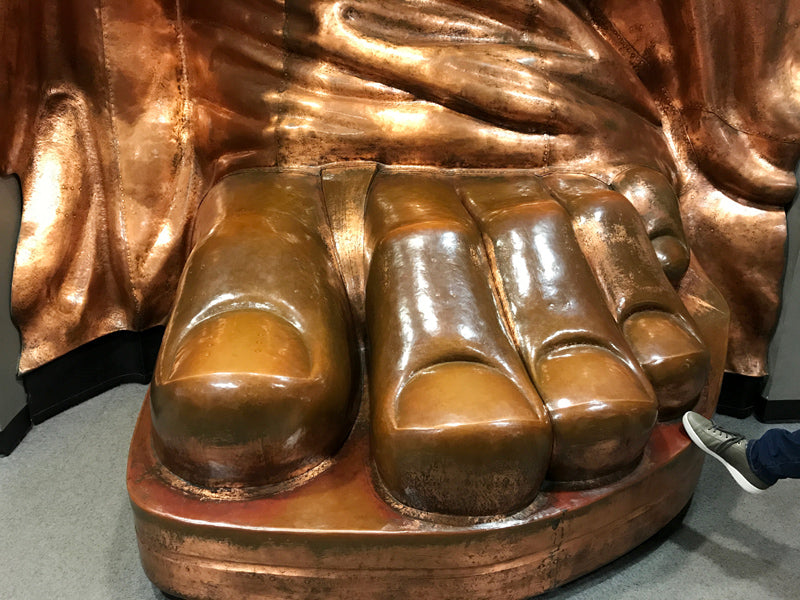Your Cart is Empty
3 min read 5 Comments
This summer I had the good fortune to visit my niece in New York City. Along with my mom and sisters, we got to see her awash in the fun exciting energy of the city, following her journalism dreams as she interned at NBC Nightly news.
Normally when I visit the big apple I stick to galleries and general nyc mayhem, but this time around we hit some iconic staples- Rockefeller, 9/11 memorial, Ellis Island, and of course the Statue of Liberty.

Part of the reason Lady Liberty was such a highlight for me (in addition to having a great reminder of America as a welcoming country) is because the process used to make her - repousse hammer forming - is one I frequently use in my sculptural work. Repousse is the art of hammering metal from the inside (or back) to create a form. It is often paired with chasing, which is hammering from the outside (or front) of the form.
I thought I'd share some images from the museum for those who are curious how she's made...

This is a plaster model of her toes. Since the statue is recreating an immense figure, models were used to ensure accuracy of scale. It's also a better way to make the parts since everything is so huge.

Here's the big toe being formed in a wood mold made from the plaster model above. In the small metals world, we often skip the model and use pitch or wax for this purpose, or even sometimes hammering on air. Since I'm often working with abstract imagery, I can form over a variety of steel stakes, sand bags, and hammers to get the shapes I want.

The same toe after hammering is completed with reinforcement bars on the interior. This metal is about 1/8" thick - thin in terms of a large scale statue (hence support bars), but quite thick in terms of small scale metalforming. I usually use metal sheet that is about less than half this thickness. Also, notice the tool to the left called a mushroom stake, one of the tools we use frequently in the holloware/metalsmithing world. It's most often used to smooth out forms from the outside that have been roughly shaped from the inside.

And voila - the finished toe as seen from the outside. Notice the rivets on the toenail - that's where it's attached to the reinforcement bar as seen in the previous picture.

You can get a better idea of the scale here with my sisters snazzy sneaker rubbing toes.

A replica of her face. At more than 8' tall this is copper forming at a most impressive scale.

Notice the seem on her nose. Smaller forms were joined together to create one solid shape. To join pieces of metal, In some cases they are riveted to each other or reinforcement bars and in others welded or soldered. Here you can see the soldered zipper seam, a process I've used on larger seamed vessels and one I've taught during holloware classes. Rather than using a butt seam, a zipper seam can handle much more distress during the hammering process.

This view shows the interior structure and stairwell up to the crown. Sadly reservations to walk up were sold out but I was able to get this peak into the inside. To the right you can see the interior of the copper with the reinforcement bars that support the form and hold things together.
Here’s a time lapse video showing one of the copper forming processes on a much smaller scale in my studio. Here I’m working on one of my vessel sculptures.
There you have it! Pretty amazing for those of us who geek out on metalsmithing.
For those of you who want first hand experience with this process, I teach the process in a variety of ways, like bowl making and the masks below.
Be sure to subscribe to receive my emails to be the first in the know when I'm offering a class.

Want your very own metal art made using these same processes?
March 07, 2021
agreed Johnathan! Those dudes must have had some burly arms. If you find yourself in NYC you should definitely check it out. Be sure to sign up in advance so you can go in the pedestal (where the museum and these replicas are located). If you’re feeling ambitious and schedule early, climb up to the crown. I believe they’ll be opening a new museum next the statue sometime in the near future so this info could change..
March 07, 2021
Really very impressive, thank you for this beautiful trip in the way that the statue was made. I wonder how the pieces are put together so that there are no joints that appear on the outside. Is it welded with copper solder and ground? If you know the answer I would be curious know, thank you.
March 07, 2021
And, equally impressive is imagining the size of the sheets of copper to construct the face and other sections of the piece.
March 07, 2021
IMPRESSIVE. Last time I was there we were not allowed to go inside. Guess I’ll have to go back.
Comments will be approved before showing up.

1 min read 1 Comment

5 min read

4 min read
20 music box sculpture designs telling the stories that make a house a home. Originally displayed in a larger art installation titled Constructing Deconstruction, each individual box is only available in an edition of 10.
Catherine Grisez
March 07, 2021
Daniel – the statue is an amazing feat of workmanship! If you look closely at the details of the toe and nose (from the prototypes), you can see rivets and solder joints. They are visible from the outside but due to the scale and built up patina, they aren’t highly noticeable.